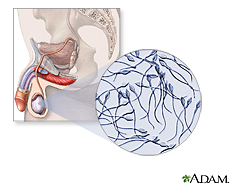
Infertility Update
MedlinePlus sent this bulletin at 04/18/2016 01:10 PM EDTNew on the MedlinePlus Infertility page:
04/13/2016 02:39 PM EDT

Source: National Library of Medicine - 

03/01/2016 01:36 PM EST

Source: National Library of Medicine - 

03/01/2016 01:36 PM EST

Source: National Library of Medicine - 

03/01/2016 01:36 PM EST

Source: National Library of Medicine - 

03/01/2016 01:36 PM EST

Source: National Library of Medicine - 



National Institutes of Health
Languages
Infertility means not being able to become pregnant after a year of trying. If a woman can get pregnant but keeps having miscarriages or stillbirths, that's also called infertility.
Infertility is fairly common. After one year of having unprotected sex, about 15 percent of couples are unable to get pregnant. About a third of the time, infertility can be traced to the woman. In another third of cases, it is because of the man. The rest of the time, it is because of both partners or no cause can be found.
There are treatments that are specifically for men or for women. Some involve both partners. Drugs,assisted reproductive technology, and surgery are common treatments. Happily, many couples treated for infertility go on to have babies.
NIH: National Institute of Child Health and Human Development
- Scientists Spot 'Switch' That Helps Sperm Penetrate Egg (03/29/2016, HealthDay)
- Women Who Survive Childhood Cancer Stand Good Chance of Having Kids (03/23/2016, HealthDay)
- Causes of Infertility (Reproductive Health Technologies Project)
- Evaluating Infertility (American College of Obstetricians and Gynecologists)
- How Is Infertility Diagnosed?
 (National Institute of Child Health and Human Development)Available in Spanish
(National Institute of Child Health and Human Development)Available in Spanish - Prerequisite Testing for Infertility Treatment (Society for Assisted Reproductive Technology)
- Protect Your Fertility (American Society for Reproductive Medicine) - PDF
- Fertility Herbs: Do They Enhance Fertility? (Mayo Foundation for Medical Education and Research)
- Intrauterine Insemination (IUI) (Mayo Foundation for Medical Education and Research)
- MedlinePlus: Assisted Reproductive Technology
 (National Library of Medicine)Available in Spanish
(National Library of Medicine)Available in Spanish - Treating Infertility (American College of Obstetricians and Gynecologists)Available in Spanish
- What Infertility Treatments Are Available?
 (National Institute of Child Health and Human Development)
(National Institute of Child Health and Human Development)
- Infertility Counseling and Support: When and Where to Find It (American Society for Reproductive Medicine) - PDF
- Psychological Component of Infertility (American Society for Reproductive Medicine)
- Stress and Infertility (American Society for Reproductive Medicine) - PDF
- Age and Fertility (American Society for Reproductive Medicine) - PDF
- Diethylstilbestrol (DES) and Cancer
 (National Cancer Institute)Available in Spanish
(National Cancer Institute)Available in Spanish - Fertility Drugs and the Risk of Multiple Births (American Society for Reproductive Medicine) - PDF
- Secondary Infertility: Why Does It Happen? (Mayo Foundation for Medical Education and Research)
- Sexual Dysfunction and Infertility (American Society for Reproductive Medicine) - PDFAvailable in Spanish
- Smoking and Infertility (American Society for Reproductive Medicine) - PDF
- STDs and Infertility (Centers for Disease Control and Prevention)
- Weight and Fertility (American Society for Reproductive Medicine) - PDF
- What Is Fertility Preservation?
 (National Institute of Child Health and Human Development)Available in Spanish
(National Institute of Child Health and Human Development)Available in Spanish
- Genetics Home Reference: 17-beta hydroxysteroid dehydrogenase 3 deficiency
 (National Library of Medicine)
(National Library of Medicine) - Genetics Home Reference: 3-beta-hydroxysteroid dehydrogenase deficiency
 (National Library of Medicine)
(National Library of Medicine) - Genetics Home Reference: 46,XX testicular disorder of sex development
 (National Library of Medicine)
(National Library of Medicine) - Genetics Home Reference: androgen insensitivity syndrome
 (National Library of Medicine)
(National Library of Medicine) - Genetics Home Reference: Bloom syndrome
 (National Library of Medicine)
(National Library of Medicine) - Genetics Home Reference: Leydig cell hypoplasia
 (National Library of Medicine)
(National Library of Medicine) - Genetics Home Reference: Swyer syndrome
 (National Library of Medicine)
(National Library of Medicine)
- Understanding Infertility - The Basics
 (American Society for Reproductive Medicine)
(American Society for Reproductive Medicine)
- High Plasticizer Levels In Males Linked to Delayed Pregnancy for Female Partners
 (National Institute of Child Health and Human Development)
(National Institute of Child Health and Human Development) - Infertility Research at the NICHD
 (National Institute of Child Health and Human Development)
(National Institute of Child Health and Human Development)
- ClinicalTrials.gov: Artificial Insemination
 (National Institutes of Health)
(National Institutes of Health) - ClinicalTrials.gov: Fertility
 (National Institutes of Health)
(National Institutes of Health) - ClinicalTrials.gov: Fertilization in Vitro
 (National Institutes of Health)
(National Institutes of Health) - ClinicalTrials.gov: Infertility
 (National Institutes of Health)
(National Institutes of Health) - ClinicalTrials.gov: Insemination, Artificial
 (National Institutes of Health)
(National Institutes of Health)
- Find a Urologist (Urology Care Foundation)
- National Institute of Child Health and Human Development
 Available in Spanish
Available in Spanish - womenshealth.gov (Department of Health and Human Services, Office on Women's Health)Available in Spanish
- MedlinePlus: Male Infertility
 (National Library of Medicine)Available in Spanish
(National Library of Medicine)Available in Spanish
- MedlinePlus: Female Infertility
 (National Library of Medicine)Available in Spanish
(National Library of Medicine)Available in Spanish
- Androgen insensitivity syndrome Available in Spanish
- Infertility Available in Spanish






















.jpg)










No hay comentarios:
Publicar un comentario